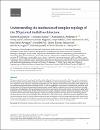Understanding the mechanics of complex topology of the 3D printed Anthill architecture
| Author | Kushwaha, Brijesh |
| Author | Kumar, Avinash |
| Author | Ambekar, Rushikesh S. |
| Author | Arya, Vinay |
| Author | Negedu, Solomon Demiss |
| Author | Bakshi, Deep |
| Author | Olu, Femi Emmanuel |
| Author | Sastri Ayyagari, Ravi |
| Author | Pal, Varinder |
| Author | Sadasivuni, Kishor Kumar |
| Author | Pugno, Nicola M. |
| Author | Bakli, Chirodeep |
| Author | Tiwary, Chandra S. |
| Available date | 2023-05-17T10:55:43Z |
| Publication Date | 2022-05-11 |
| Publication Name | Oxford Open Materials Science |
| Identifier | http://dx.doi.org/10.1093/oxfmat/itac003 |
| Citation | Kushwaha, B., Kumar, A., Ambekar, R. S., Arya, V., Negedu, S. D., Bakshi, D., ... & Tiwary, C. S. (2022). Understanding the mechanics of complex topology of the 3D printed Anthill architecture. Oxford Open Materials Science, 2(1), itac003. |
| Abstract | The present work aimed to investigate the deformation behavior of complex ant mound architectures under compression. We have used the cement casting method to extract four different ant nest morphologies. These casted cement structures were digitalized using a 3D micro-computer tomography scan. The digitized structures were simulated under different loading conditions using finite-element methods (FEMs). In order to supplement the numerical understanding, the digital architectures were 3D printed and experimentally tested under uniaxial loading conditions. Ants produce a variety of complex architectures for adapting to the surrounding environment and ants' needs. Ant mound consists of at least one pillar with a broad base tapered toward its tip. Anthill architectures have unique topological features. Mechanical strength of ant mould can be 600 times enhanced by tuning topology. Thickness and angle of pillars have huge effect on load-bearing property. The branched structures can endure larger stress and deform in the process under a volumetric pressure application, making them sacrificial units for extreme disasters like floods and earthquakes. The 3D printing experiments and FEMs simulations are needed to tackle the complex ant mound architectures and appear in good agreement, suggesting a robust design and thus the possibility of constructing anthill-inspired civil buildings with a tree-trunk-like geometry. |
| Sponsor | C.S.T. acknowledges Asian Office of Aerospace Research and Development (AOARD) grant nos. FA2386-19-1-4039 and FA2386-21-1-4014, Ramanujan fellowship and core research grant of SERB, India, the Naval research board of India and the funding received from STARS project by MHRD, India. |
| Language | en |
| Publisher | Oxford University Press |
| Subject | 3D printing ant mound bio-inspired architecture mechanical properties polylactic acid Young's modulus |
| Type | Article |
| Issue Number | 1 |
| Volume Number | 2 |
| ESSN | 2633-6979 |
Files in this item
This item appears in the following Collection(s)
-
Center for Advanced Materials Research [1633 items ]


